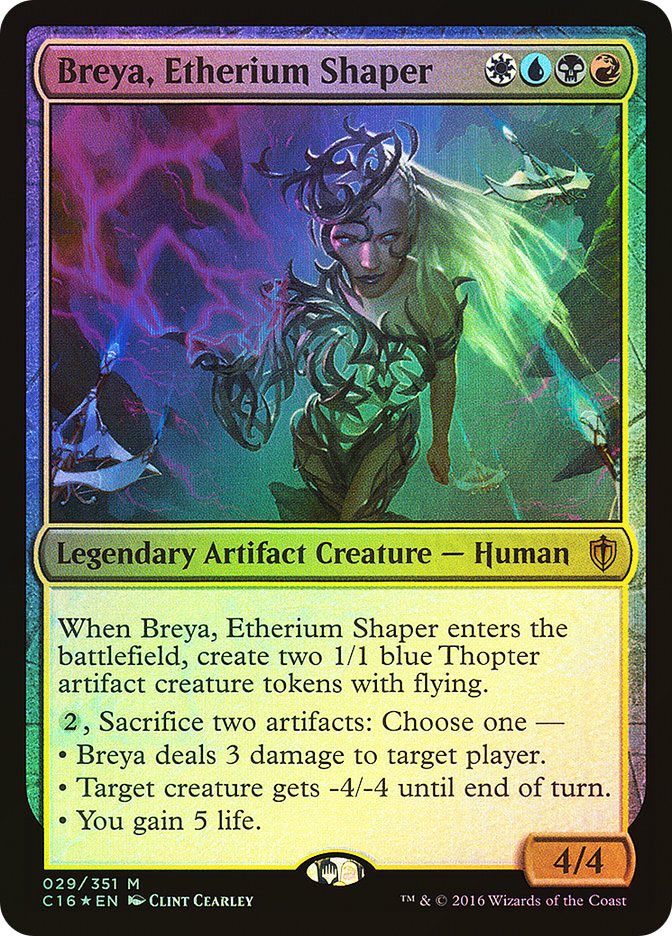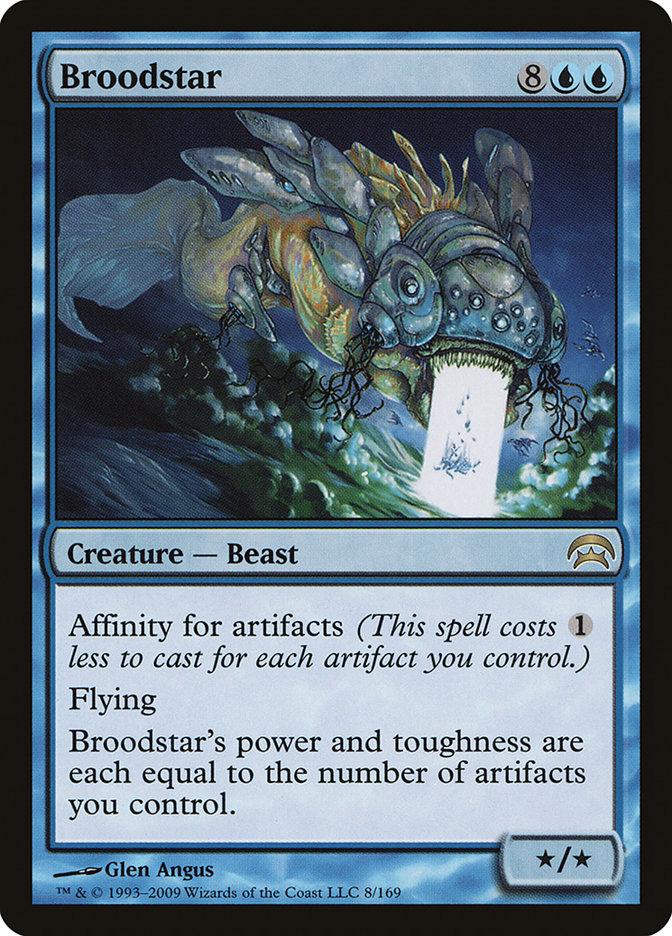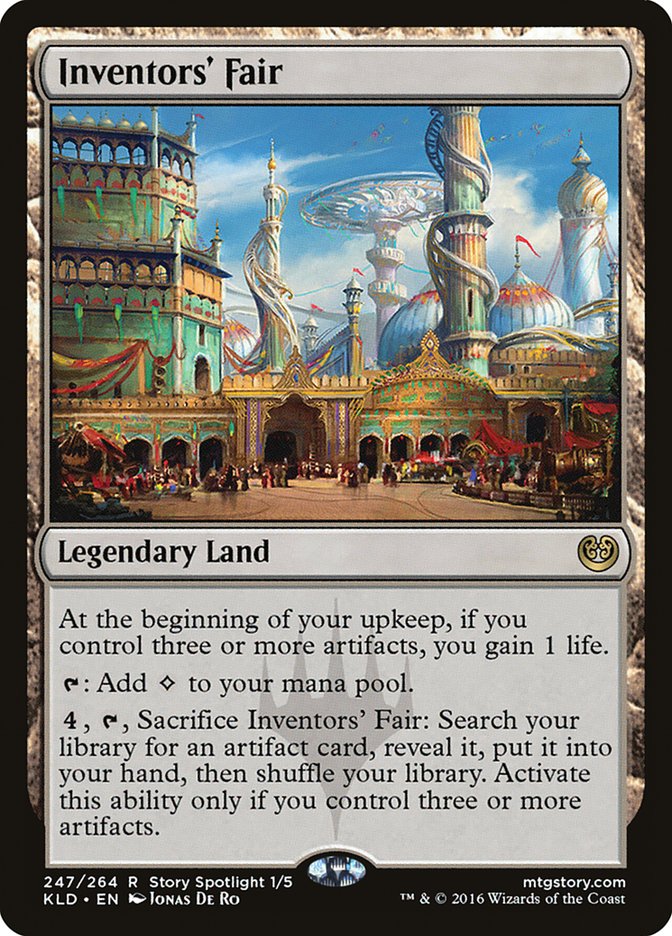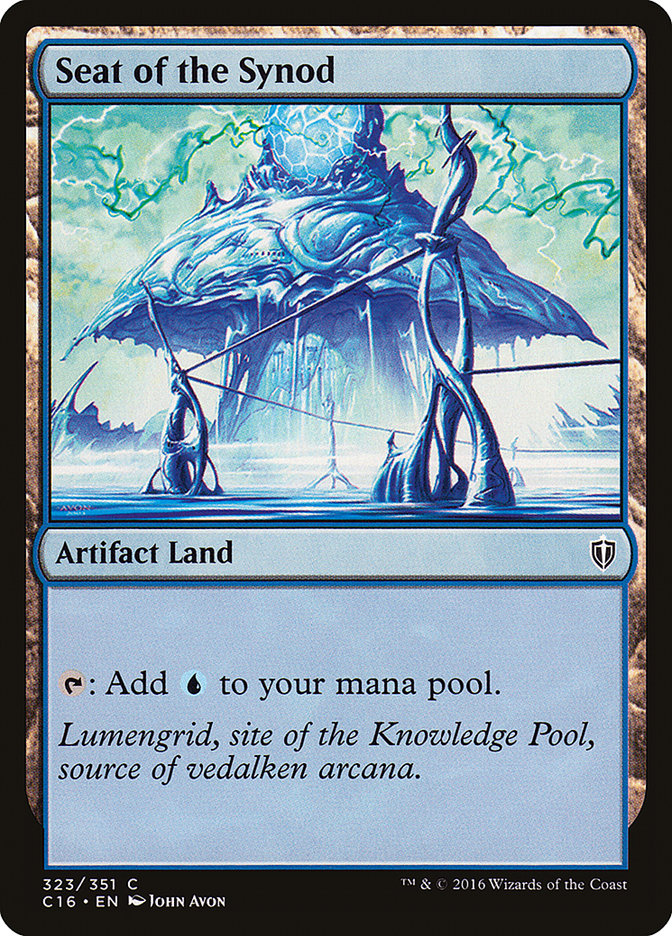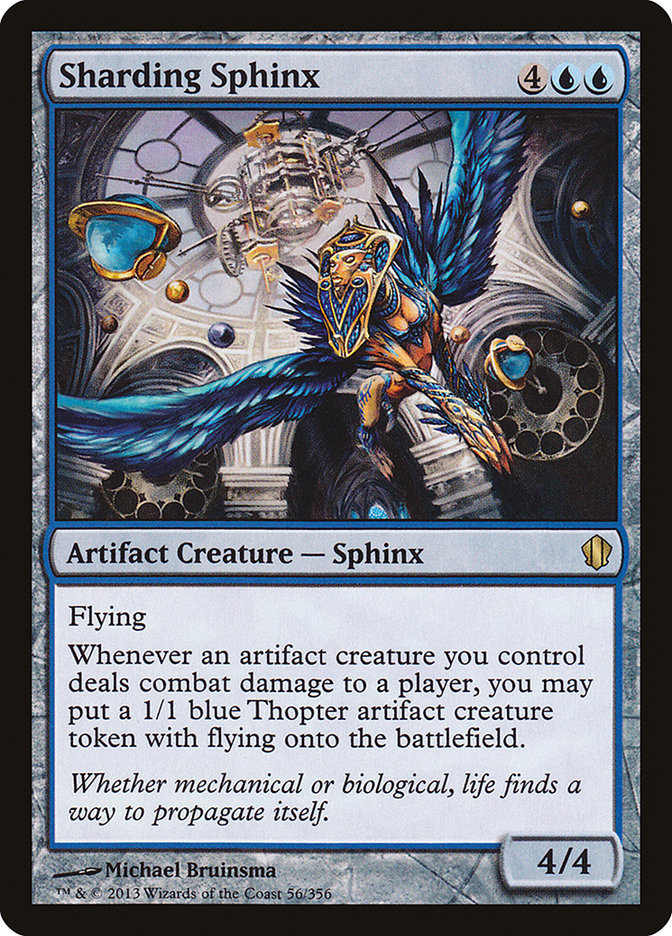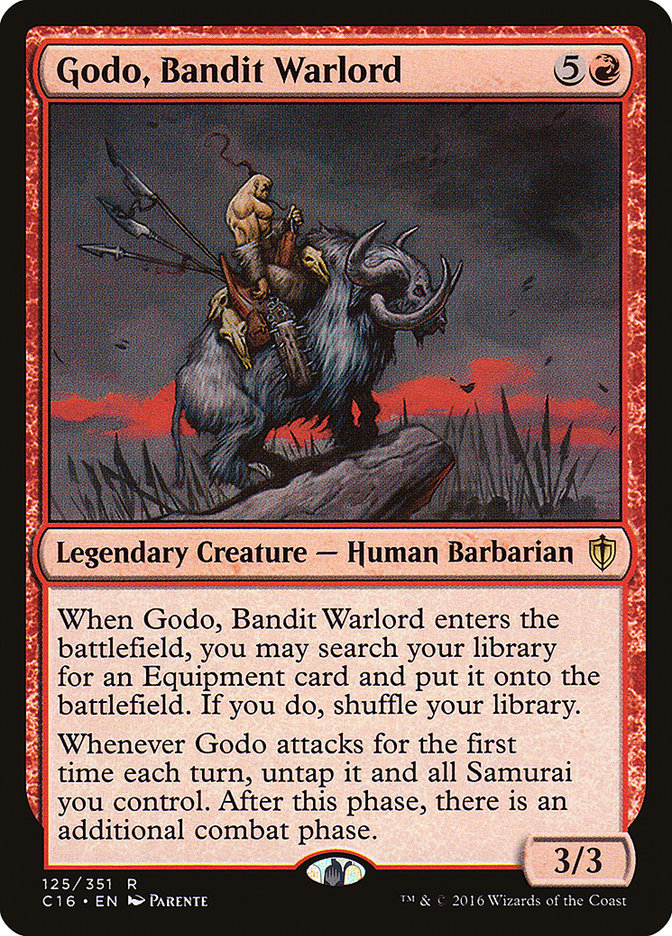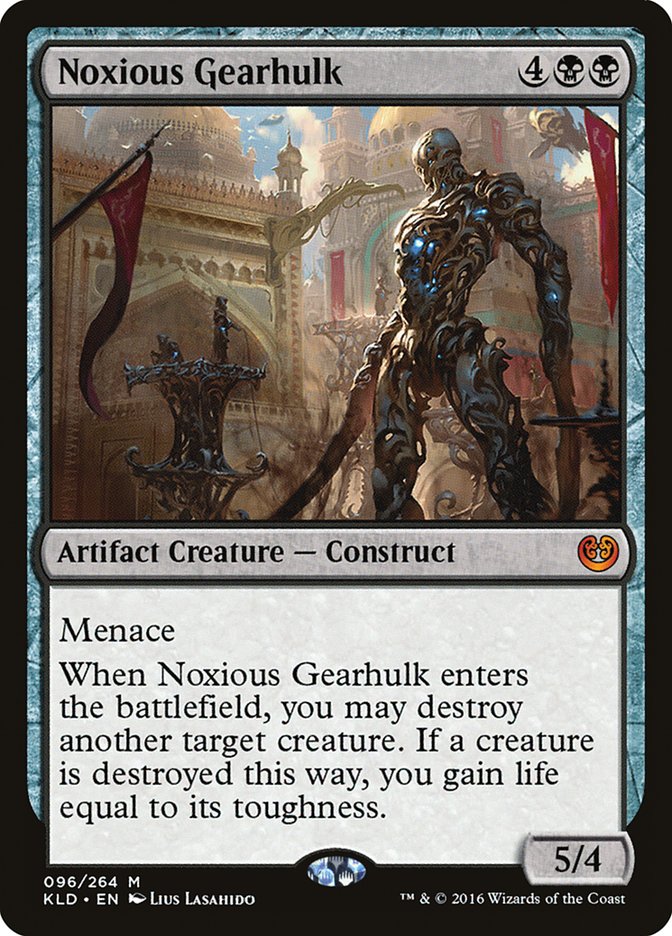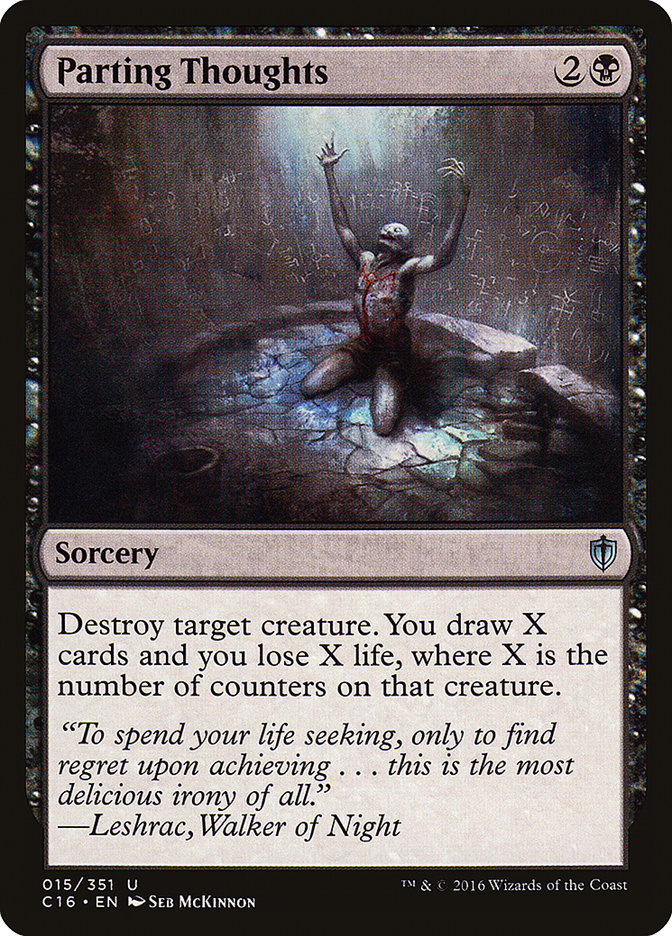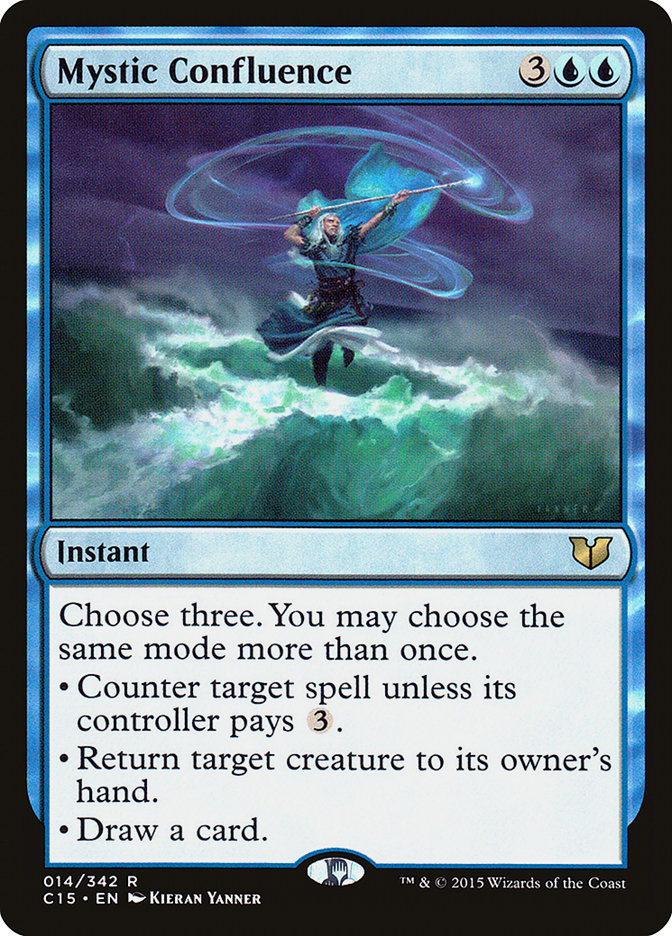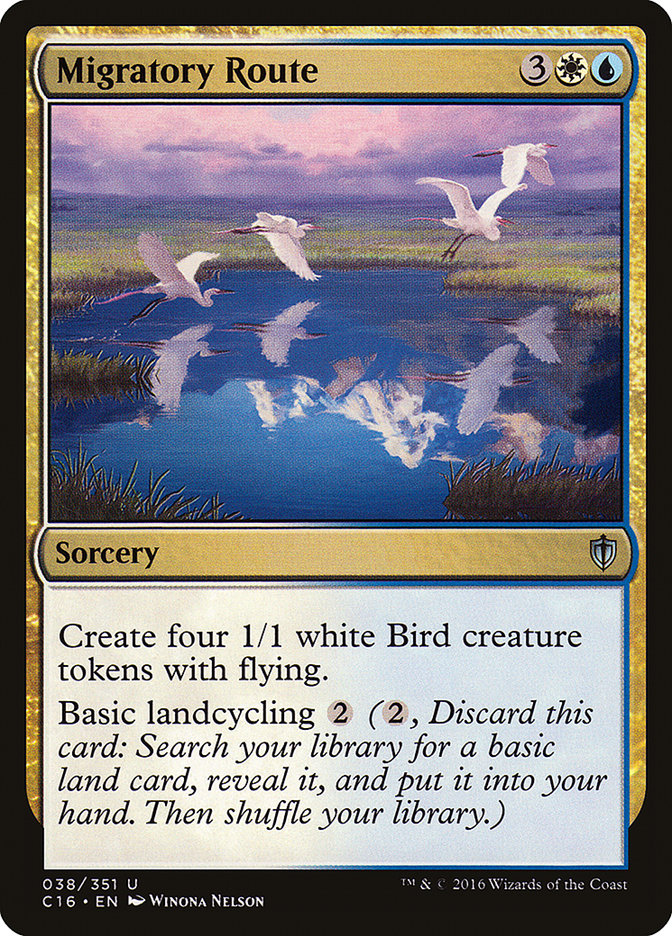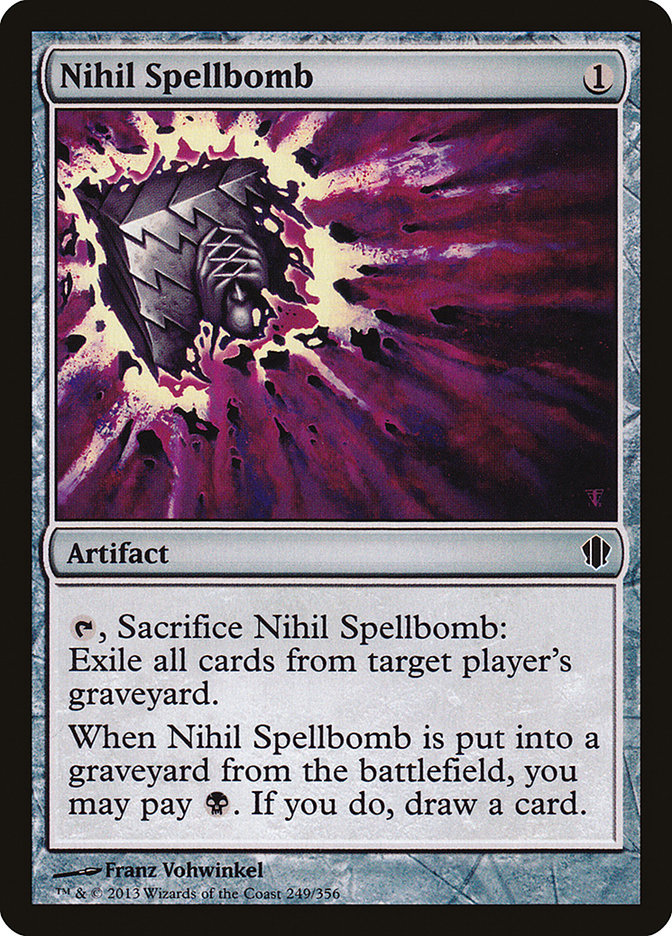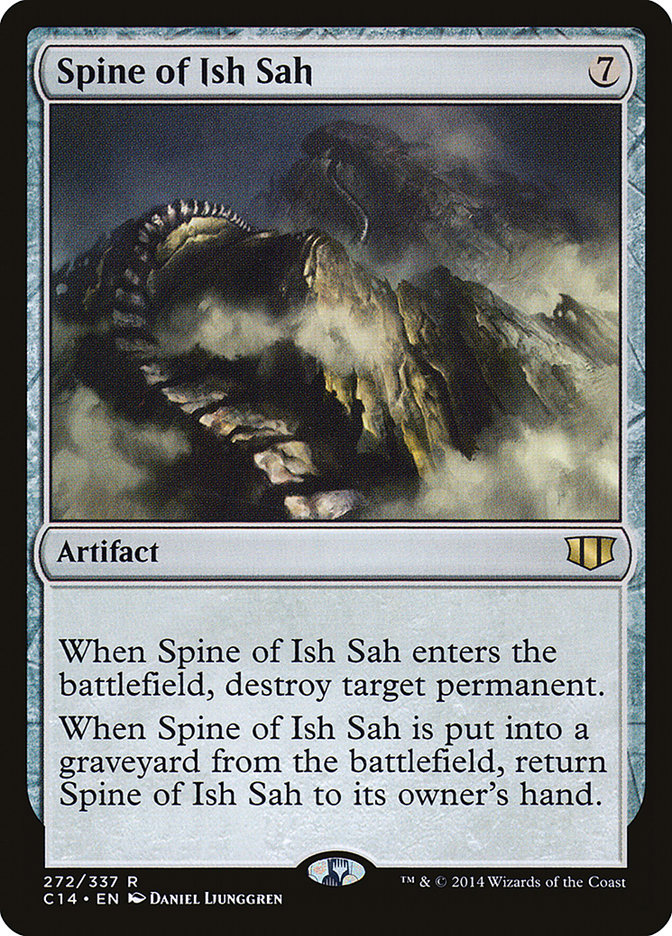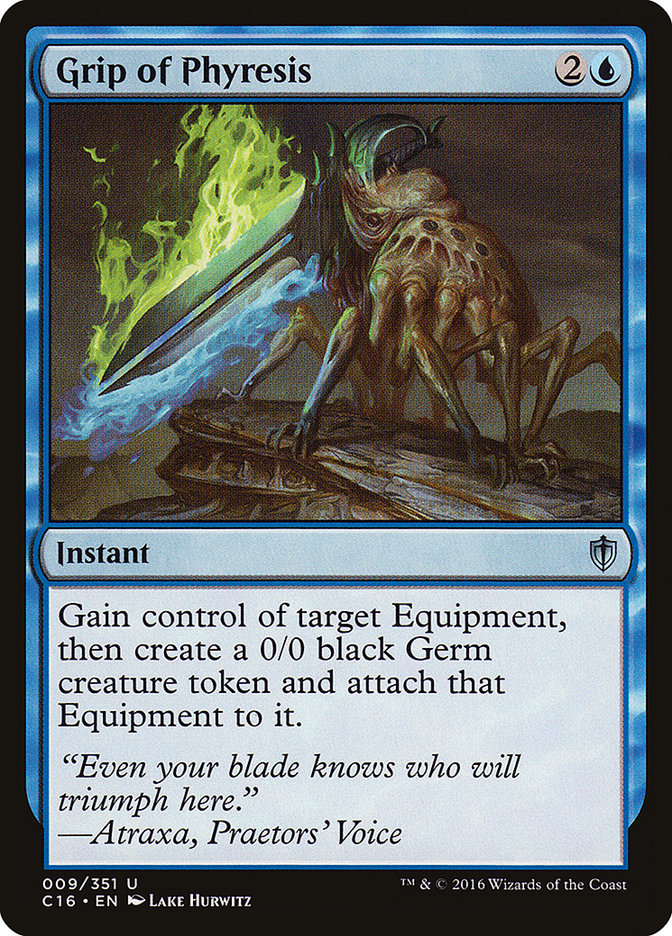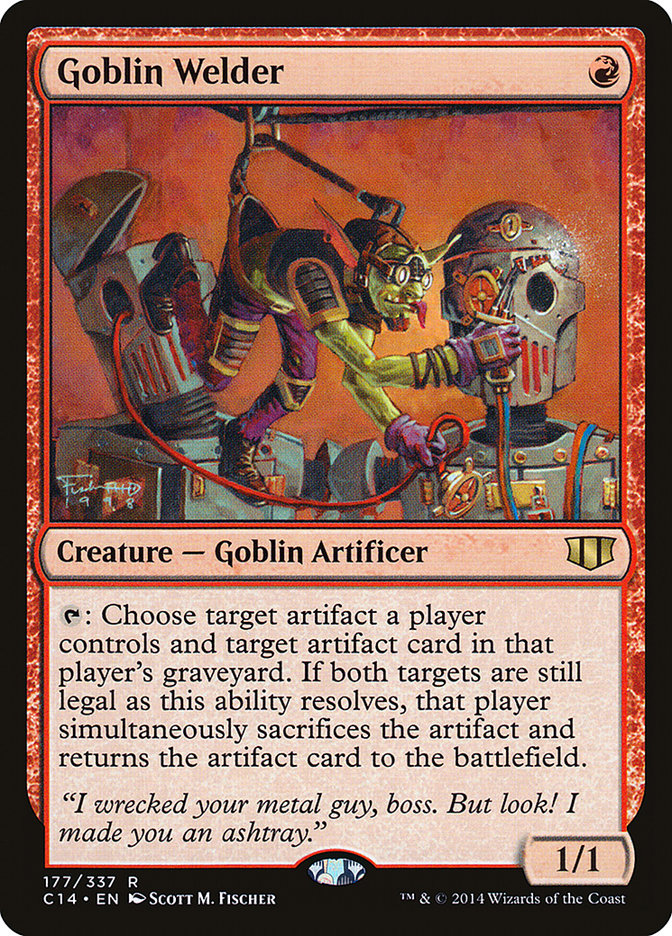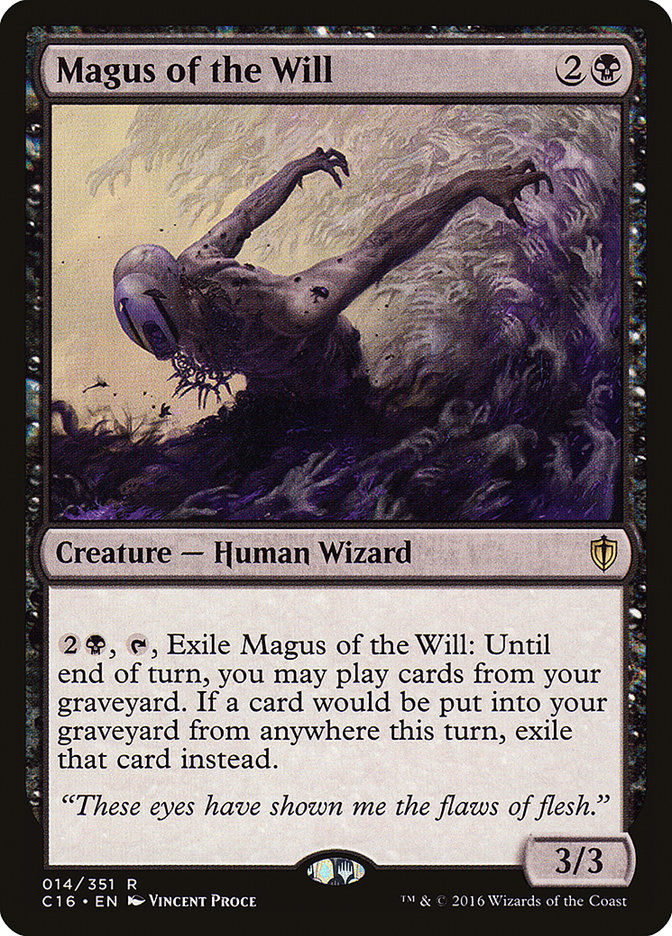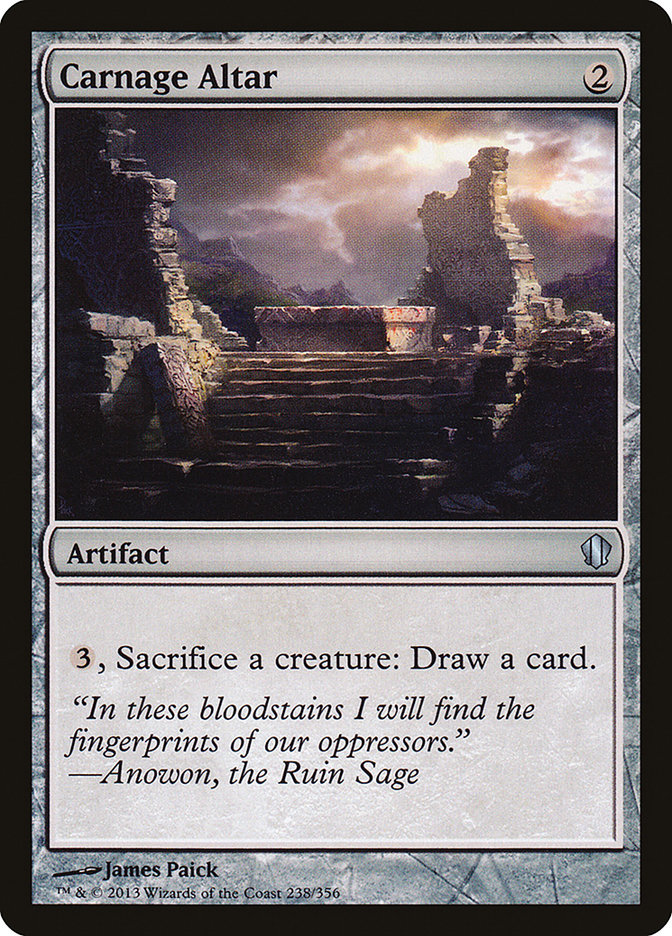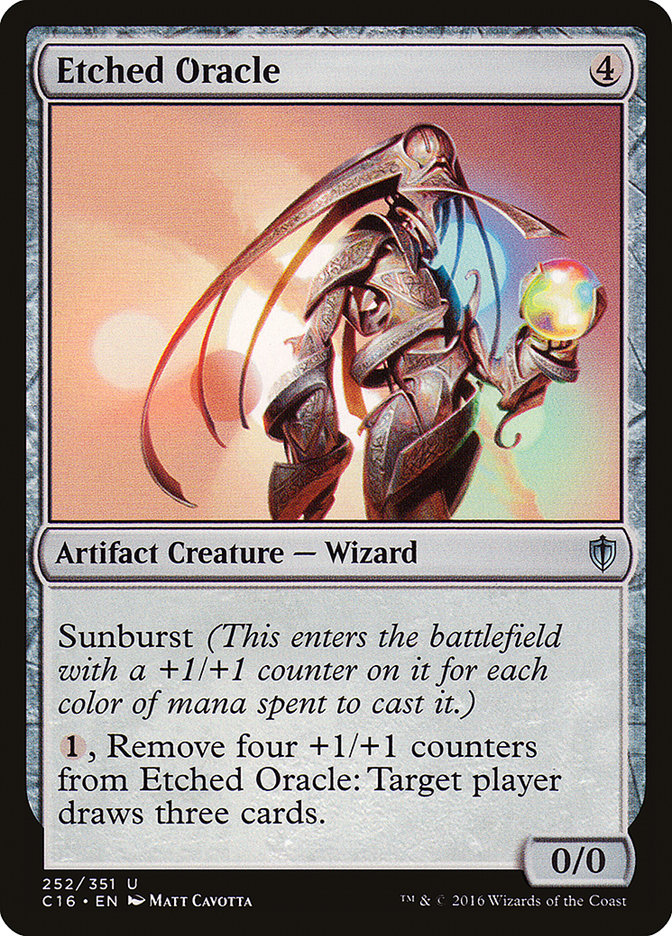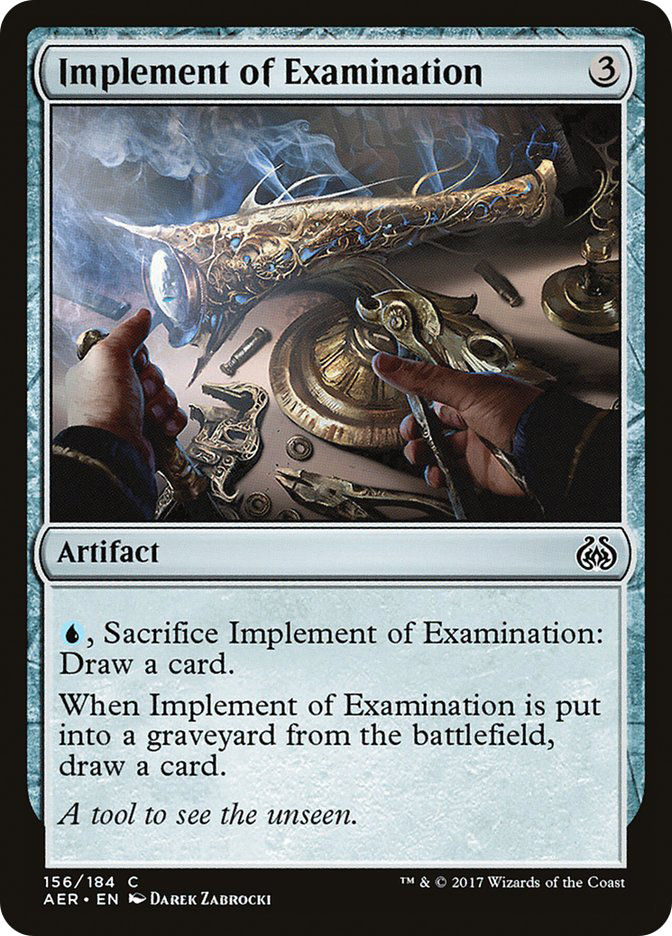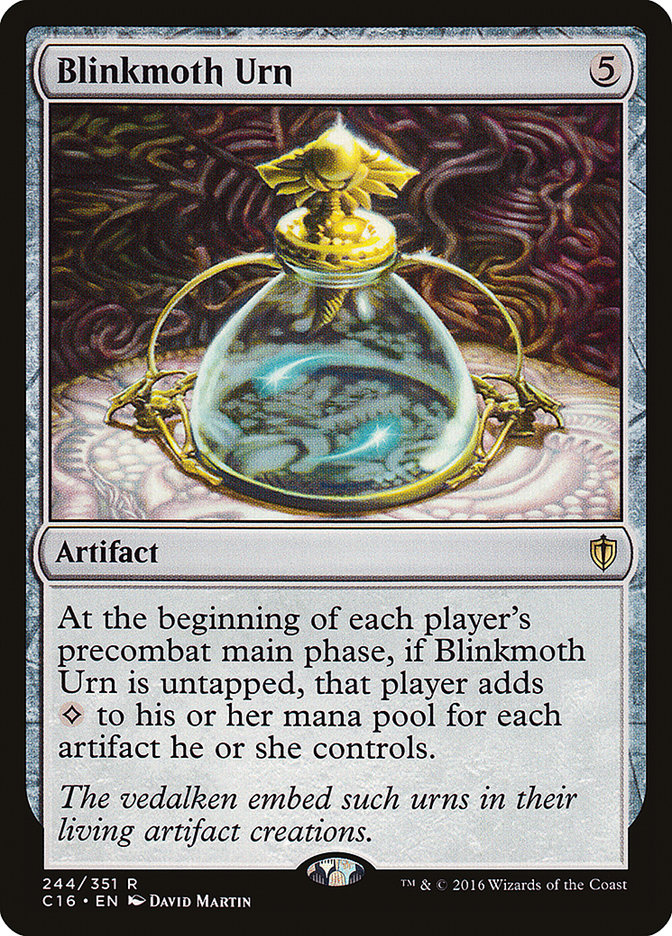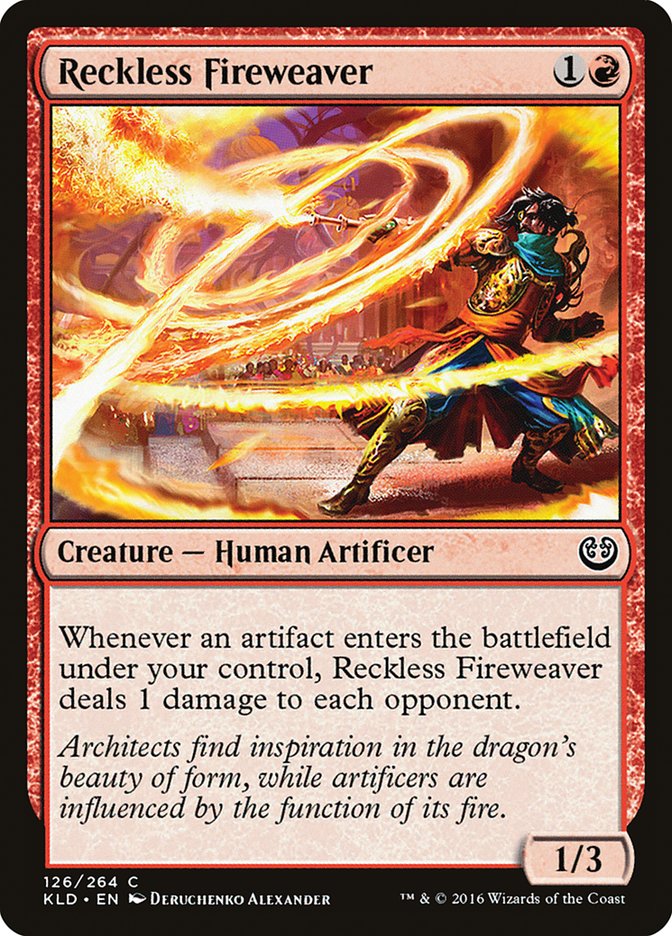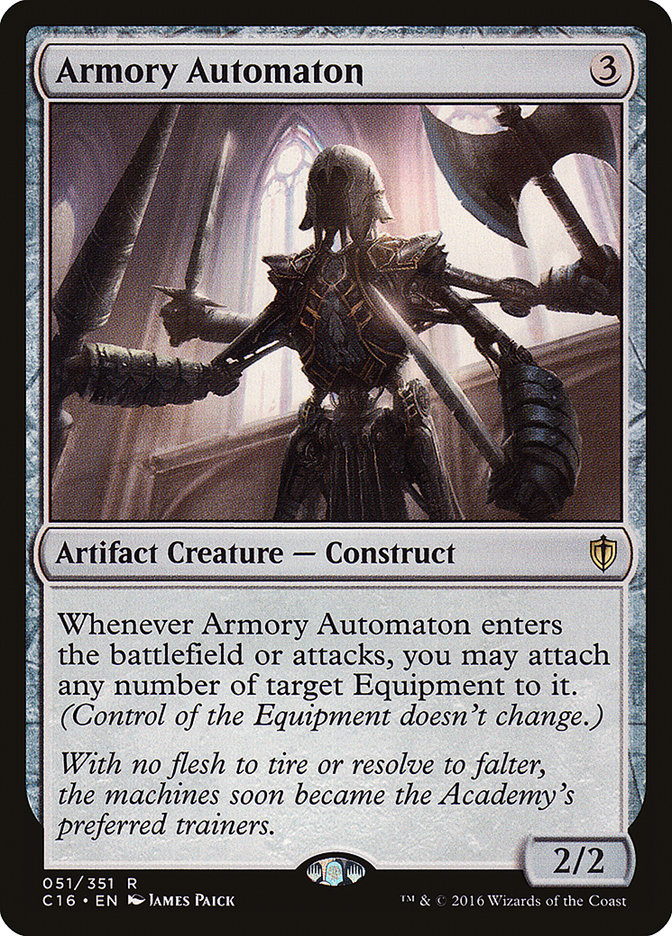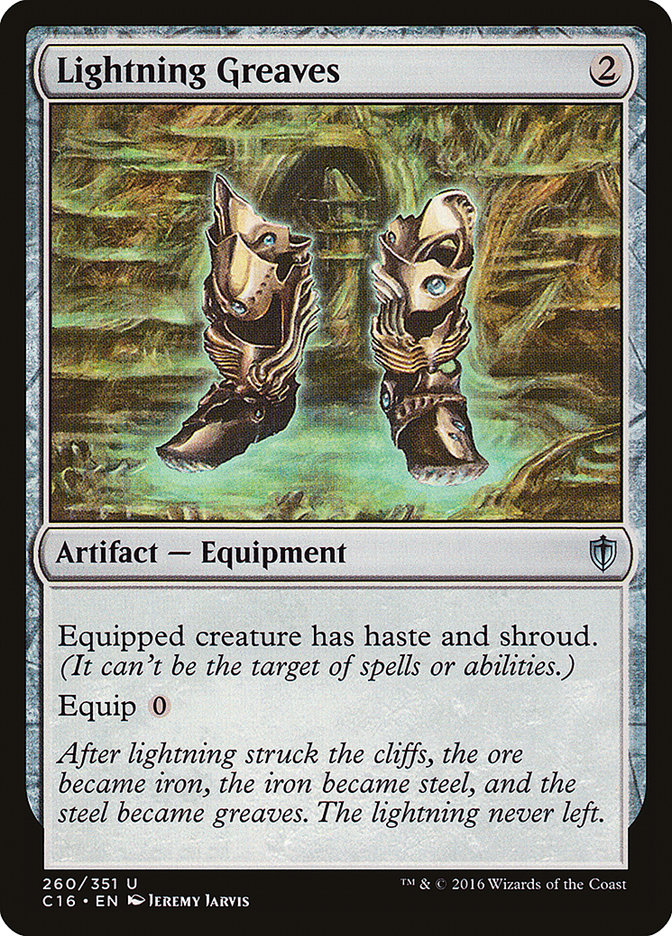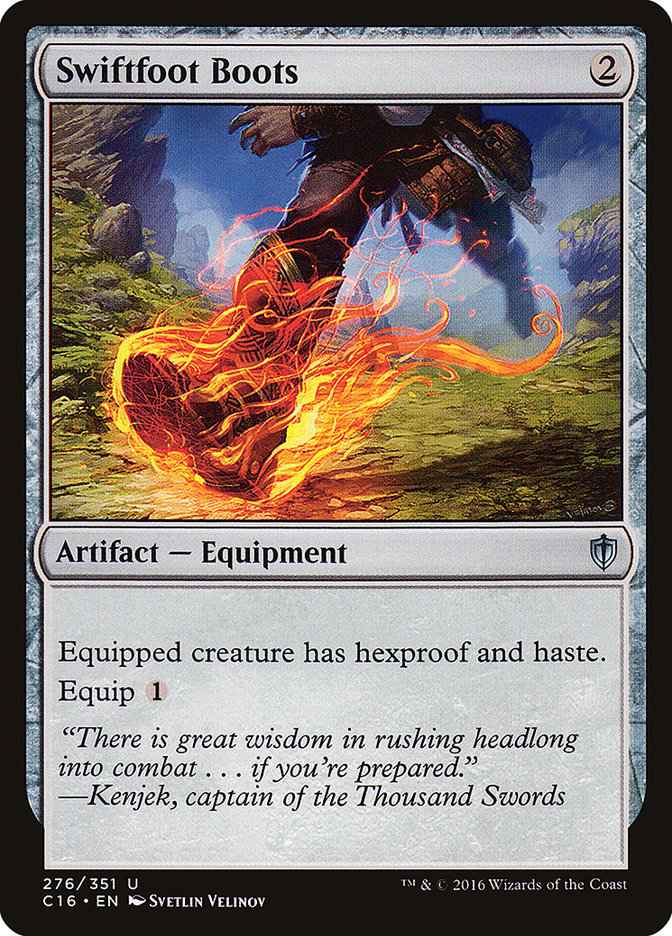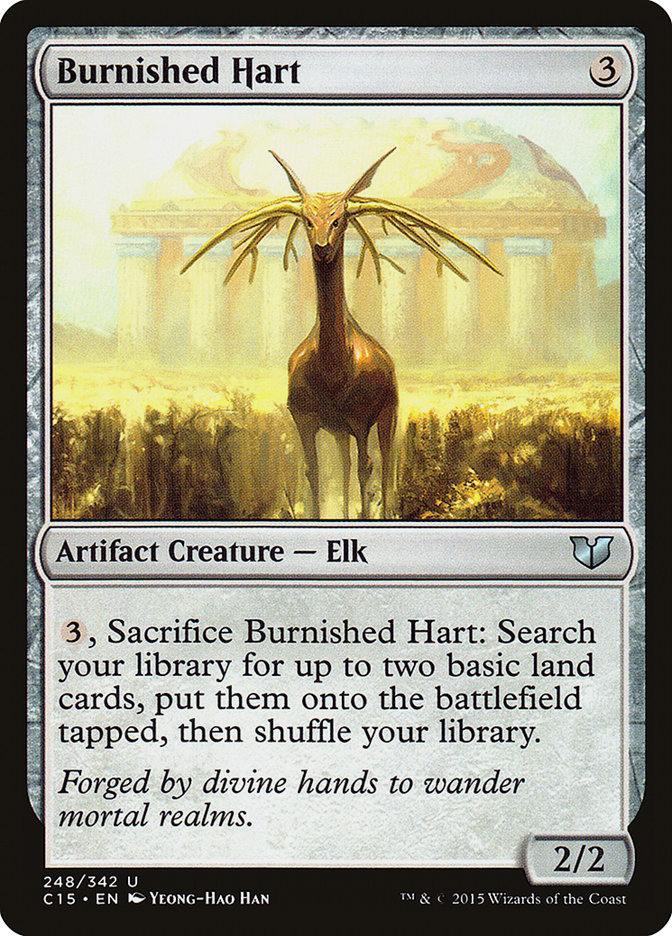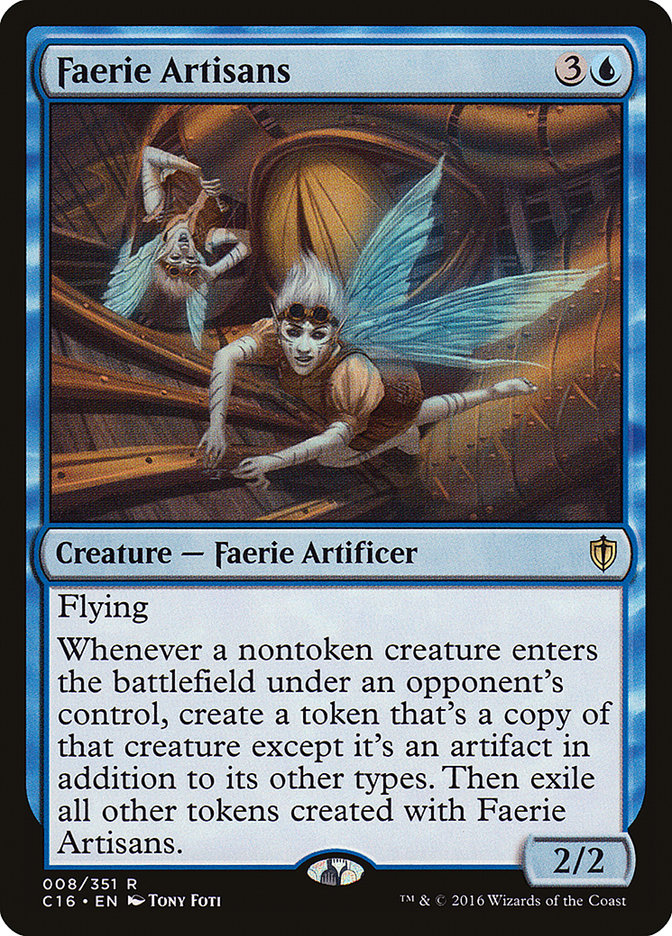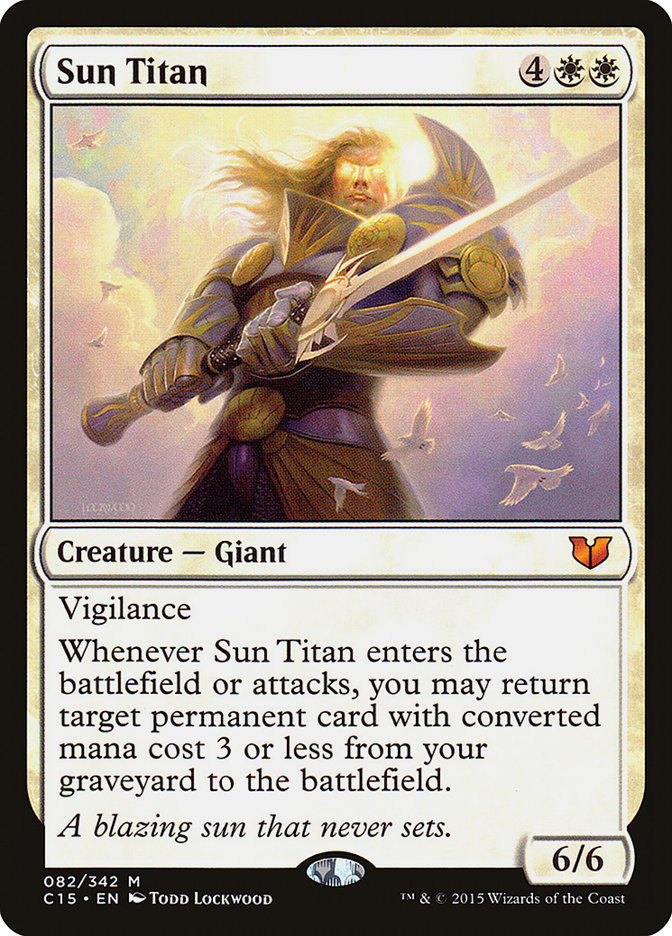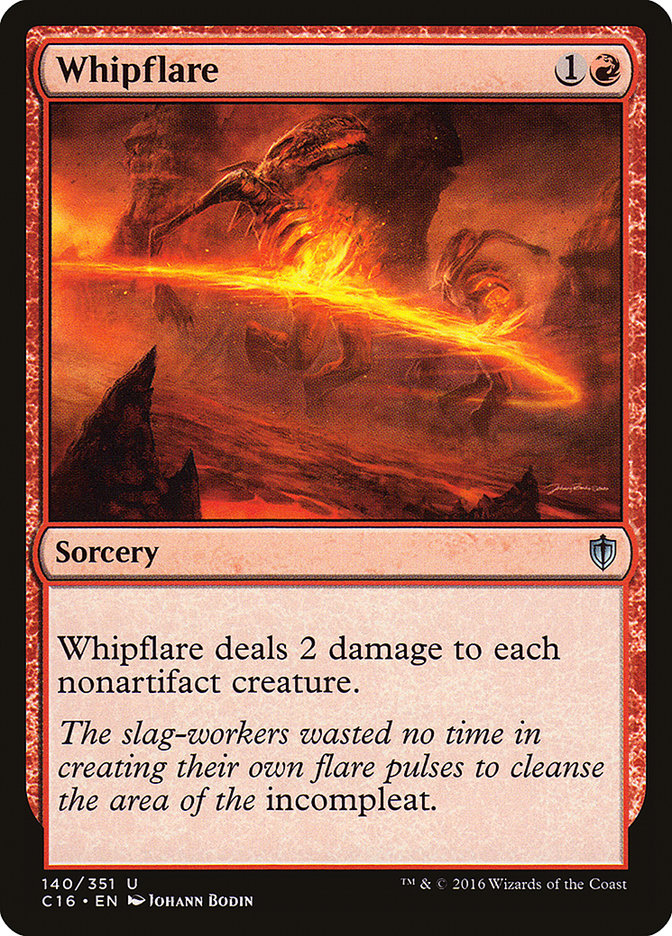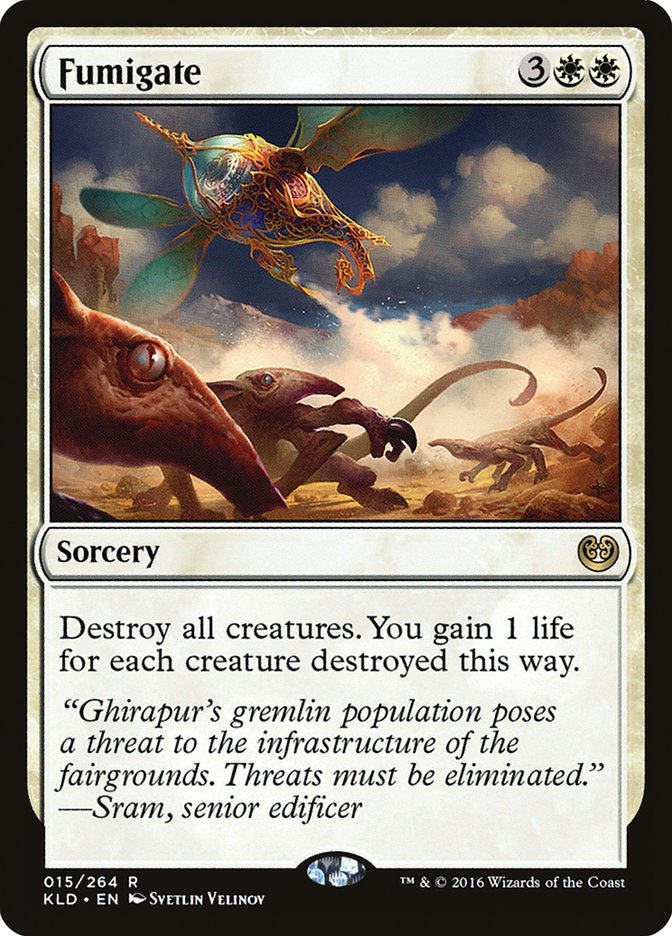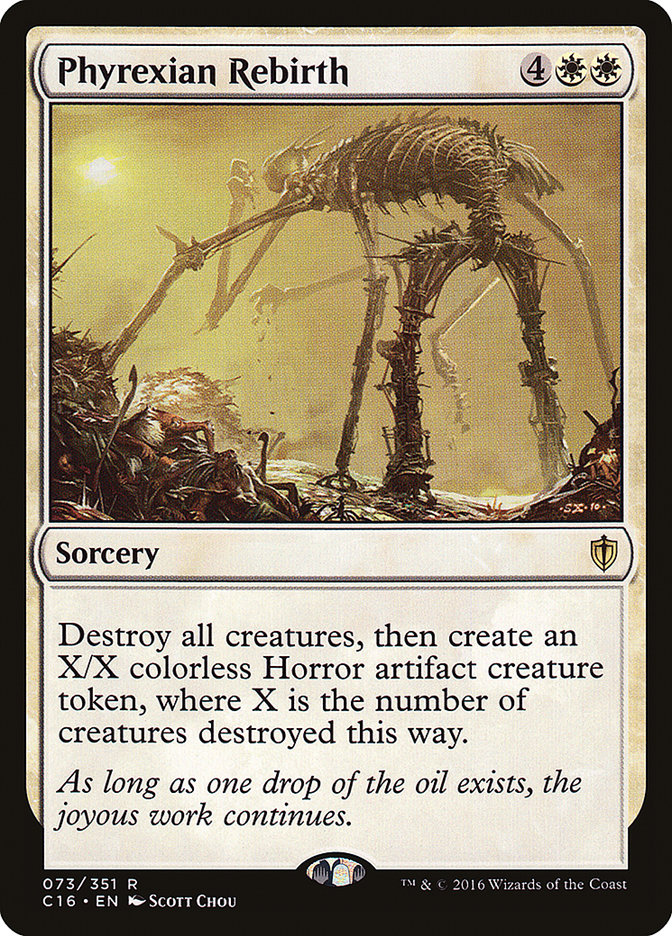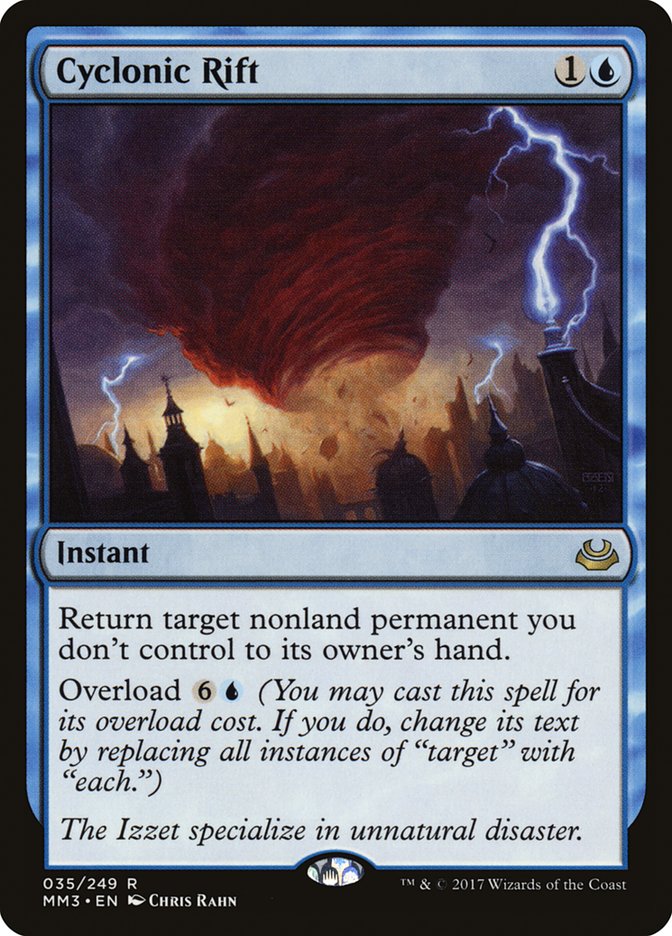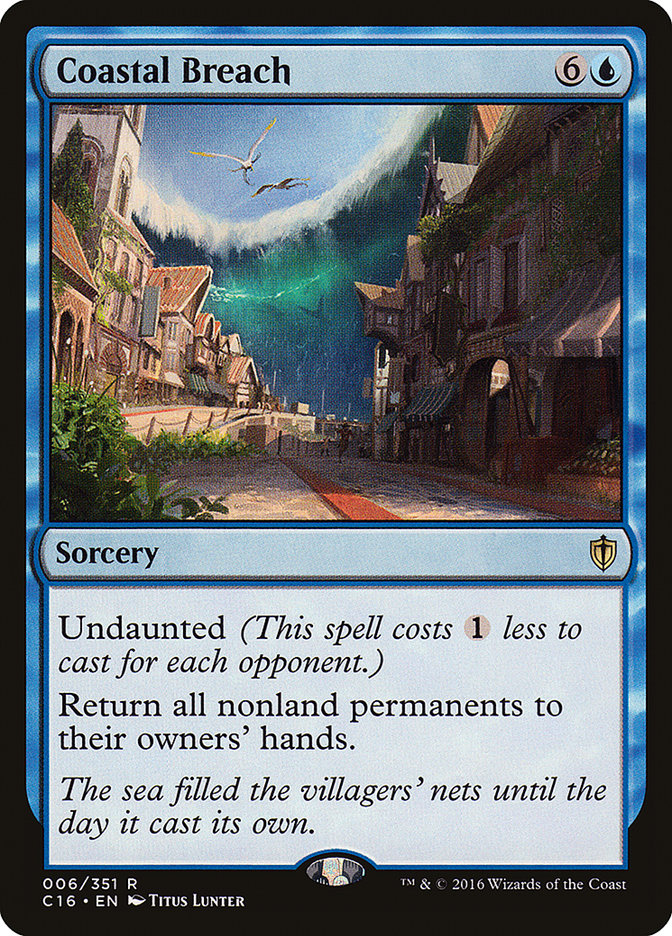About six weeks ago, when fellow Commander Rules Committee member Toby Elliott visited, we decided to build a Breya, Etherium Shaper deck together. I’m not sure how we got onto Breya (although I seem to recall some discussion about it being the weakest of the Commander 2016 commanders), but that’s what we settled on. Then, sometime in the middle of watching the whole season’s run of The Good Place, perhaps the most innovative show to hit broadcast television in a long, long time, we decided it would be cooler to both independently build versions and then offer them up for comparison.
A funny thing happened on the way to building my version: I couldn’t get excited about it. I wanted to, because sacrificing artifacts for fun and profit seemed like a grand idea, but Breya herself just left me a little cold. Life totals in Commander are too high to make her first ability relevant. The cost seemed too high for the value of the second, leaving only the life-gaining third ability as the thing to focus on. Even then, I wasn’t too thrilled. Then something occurred to me which got me far more interested.
The Commander products are intended to be both playable out of the box and starting points for newer players to tinker with once they’re comfortable with the format. The decks’ playability were borne out when Magic Community Cup star Tom Delia played the Kynaios and Tiro of Meletis version with great success in a game which occurred just after the one I wrote about last week. It turns out we all walked into the Price of Progress trap after Kynaios and Tiro of Meletis stayed on the battlefield for about eight turns.
I decided that for my version, I’d look at the deck through the lens of simply cracking it open and delving into how I’d update the deck to fit my particular style and play group. But first, let’s look at Toby’s build—which was, by the way, pretty much the direction in which I was initially headed as well, so the comparisons wouldn’t have been all that interesting.
Toby’s Version
First things first. We’ll listen to a little of what Toby himself says about the deck and then check out his list.
If you’re going to build something, build the extreme version first and see if it’s cool. There’ll be time to patch the weaknesses later. This is the first pass at a Breya deck that’s looking to disgorge and blow up artifacts with equal aplomb.
You start with Breya’s abilities, one of creation and one of destruction. How can we leverage those tokens she’s producing? How can we ensure a steady stream of artifacts to feed her? Could we take advantage of all these little things changing zones? Prioritize the unusual: this is a chance to test out obscure fun cards like Furnace Celebration and
Nuisance Engine to see just how many one-mana artifacts might be playable in Commander. If there was ever a deck looking to use all the Stations, Breya seems like the one. Will all of this survive after a bunch of games? Almost certainly not, but exploration is half the fun.
Creatures (23)
- 1 Myr Retriever
- 1 Solemn Simulacrum
- 1 Goblin Welder
- 1 Broodstar
- 1 Trinket Mage
- 1 Auriok Salvagers
- 1 Arcbound Crusher
- 1 Disciple of the Vault
- 1 Sharding Sphinx
- 1 Filigree Angel
- 1 Wurmcoil Engine
- 1 Thopter Assembly
- 1 Pia and Kiran Nalaar
- 1 Hangarback Walker
- 1 Smothering Abomination
- 1 Filigree Familiar
- 1 Master Trinketeer
- 1 Metalwork Colossus
- 1 Reckless Fireweaver
- 1 Marionette Master
- 1 Scrap Trawler
- 1 Treasure Keeper
- 1 Maverick Thopterist
Planeswalkers (3)
Lands (28)
- 3 Plains
- 3 Swamp
- 2 Mountain
- 3 Island
- 1 Vault of Whispers
- 1 Seat of the Synod
- 1 Great Furnace
- 1 Ancient Den
- 1 Vivid Creek
- 1 Vivid Meadow
- 1 Arcane Sanctum
- 1 Crumbling Necropolis
- 1 Rupture Spire
- 1 Bojuka Bog
- 1 Transguild Promenade
- 1 Nomad Outpost
- 1 Mystic Monastery
- 1 Myriad Landscape
- 1 Foundry of the Consuls
- 1 Inventors' Fair
- 1 Spire of Industry
Spells (45)
- 1 Sol Ring
- 1 Meekstone
- 1 Darksteel Ingot
- 1 Skullclamp
- 1 Wayfarer's Bauble
- 1 Summoning Station
- 1 Salvaging Station
- 1 Roar of Reclamation
- 1 Grinding Station
- 1 Blasting Station
- 1 Nuisance Engine
- 1 Dimir Signet
- 1 Terrarion
- 1 Izzet Signet
- 1 Orzhov Signet
- 1 Azorius Signet
- 1 Rakdos Signet
- 1 Chromatic Star
- 1 Coalition Relic
- 1 Scourglass
- 1 Relic of Progenitus
- 1 Open the Vaults
- 1 Expedition Map
- 1 Elixir of Immortality
- 1 Brittle Effigy
- 1 Furnace Celebration
- 1 Nihil Spellbomb
- 1 Spine of Ish Sah
- 1 Ichor Wellspring
- 1 Mycosynth Wellspring
- 1 Conjurer's Closet
- 1 Trading Post
- 1 Dictate of Erebos
- 1 Thopter Spy Network
- 1 Tamiyo's Journal
- 1 Magnifying Glass
- 1 Confirm Suspicions
- 1 Underhanded Designs
- 1 Renegade Map
- 1 Implement of Combustion
- 1 Implement of Examination
- 1 Hidden Stockpile
- 1 Efficient Construction
- 1 Universal Solvent
- 1 Servo Schematic

The thing which jumped out and grabbed me is that he’s running 28 lands. I even double-checked with him to make sure he hadn’t messed up. As you see, he’s running loads of mana rocks, so he’s probably always going to get to three mana even if he keeps a two-land hand. Those of us on the RC use pretty liberal mulligan rules when we play (the Gis Mulligan, which I discussed a few years back), since we know no one will abuse them. I don’t think I’d short a land count this much, but there’s obviously method to Toby’s madness. With the deck’s ability to regrow some of those rocks even if they get blown up, the lower land count begins to make some sense. It just feels a little risky to me, even in low-powered groups.
After that, I love some of his choices. Broodstar is particularly spicy. I looked down the “affinity for artifacts” line myself but eventually decided that I couldn’t do every cool thing that I thought of. Disciple of the Vault is an outside-the-box choice which definitely fits into this build.
My Version
I started with the list straight out of the box, which you can find here. Since the deck, called Invent Superiority, is certainly already playable in all but the most competitive settings, I figured I’d just tweak it along its intended path as opposed to doing a complete overhaul. I’d also like to keep the new cards to relative bargains, hoping to demonstrate that one doesn’t need to spend a pile of money to get into the format. The deck plus the upgrades cost less than $100. Spending large amounts of cash comes later, once you’re hooked like I am.
My process was relatively simple. First, I set a maximum of fifteen changes. It’s an arbitrary limit, but it just felt like the right number to keep the deck’s initial intention. I took out cards which I think don’t necessarily fit into the deck or do enough in the format. Then I looked at cards which I think advance the deck’s themes, and finally a few straight upgrades.
In: Inventors’ Fair
Out:
I’m not a fan of the artifact lands in Commander. At least in my local group, battlefield wipes for artifacts are common enough that I’d hate to get stripped of land while my artifacts are also getting wrecked. The upsides, like one additional on the count for Cranial Plating and friends, aren’t worth the risks. Obviously, Darksteel Citadel is fine since it’s indestructible. You’ll be gaining life more often than not with Inventors’ Fair, plus it’s an emergency tutor if you need. Regular readers know that I’m not a tutor fan, but the more limited ones—the kind which only grab one kind of card—are mostly okay with me. If you’d like a pricier upgrade for this slot, Academy Ruins fits quite nicely into the deck.
In: Sharding Sphinx
Out: Godo, Bandit Warlord
Godo is out because I’d rather not be half-hearted on the Equipment plan and there are no other Samurai to take advantage of the additional combat step. There are only three Equipment cards in the original list, and while none of them are going anywhere, I don’t see them as a deeply necessary component of the battle plan. Sharding Sphinx, on the other hand, creates a situation in which your army gets larger and larger while providing more fodder for sacrificing (for the aforementioned fun and profit).
In: Noxious Gearhulk
Out: Parting Thoughts
Parting Thoughts is a cool card in the deck if you know the Commander 2016 decks are going to be played with each other—you’ll always have a spicy target. In a more open environment, you’re not guaranteed that to be the case, although I’ll say in each of the last dozen or so games I’ve played, Thief of Blood would have paid some dividends (save for the life loss might have been too high). If I were playing this deck in a Commander 2016 League, I would most certainly keep in Parting Thoughts and add Thief of Blood because the Breed Lethality deck, commanded by Atraxa, Praetor’s Voice, would always provide delicious fodder. Maybe Spike Cannibal wouldn’t be far behind. Noxious Gearhulk has the advantage of gaining you some life while it’s killing a creature, and you can engage in some tomfoolery to and from the graveyard because it’s an artifact.
Out: Migratory Route
Migratory Route creates Birds, not Thopters, and while the basic landcycling is nice, it’s not enough to keep the card in the deck. The deck seems to need a bit more card drawing. I’m a huge fan of Mystic Confluence’s flexibility. There are times when it’ll be the right move to counter or bounce something and draw two, or maybe even draw just one. Any way you slice it, the card gives you the kind of options you want.
In: Nihil Spellbomb
Out: Trial // Error
Trial // Error simply doesn’t do anything which I care to do in this deck, so it was pretty easy to take out. My local gang loves their graveyards, so a little control is eminently reasonable.
In: Spine of Ish Sah
Out: Grip of Phyresis
Grip of Phyresis similarly doesn’t do anything I’m interested in, but Spine of Ish Sah sure does. Being able to take out any permanent is great—albeit expensive—and then getting it back after it becomes fuel for one of the sacrifice outlets is even better.
In: Goblin Welder
Out:
This deck will be moving things in and out of its graveyard, so exiling them is the wrong call. We might as well replace it with a card which does just that thing at a very nice price, Goblin Welder. Exchanging a Thopter for Noxious Gearhulk seems like loads of upside.
In: Carnage Altar
Out: Etched Oracle
Etched Oracle is okay at drawing cards but it’s way too conditional. I’m more of a fan of Carnage Altar, which is an outlet for drawing cards off all the tokens we’ll be creating. Carnage Altar is less expensive to cast but more expensive to activate than Phyrexian Vault, but the trade-off is that Phyrexian Vault taps to activate. You can use Carnage Altar as many times as you have mana for.
Out: Blinkmoth Urn
Just a touch more card draw—which can come back later—rounds out the deck quite nicely. I’m pretty set against giving other players free stuff (especially mana) without a plan to make them somehow pay for it; at five mana, the investment on Blinkmoth Urn is way too high for my tastes for the reward, especially since my rewards are tempered by how other players will hurt me with what I give them.
Out: Armory Automaton
Again, with only three Equipment in the deck, you’re not going to do too many shenanigans with Armory Automaton unless the folks you play against are addicted to Equipment. In order to completely dagger them, you’d have to have some kind of sacrifice outlet (like the deck’s Read the Runes) to make sure the opponents don’t get them back. This deck creates and plays lots of artifacts. With Reckless Fireweaver, you don’t even need to sacrifice them to get value—it’s like a miniature version of Purphoros, God of the Forge (which of course will also fit into the deck if you’d like a serious upgrade outside our bargain target).
Out: Swiftfoot Boots
Simply put, a straight-up improvement from one card to another. This deck doesn’t do much targeting of its own creatures, so the difference between hexproof and shroud is negligible. The equip cost of zero is quite significant.
In: Burnished Hart
Out: Faerie Artisans
Being a nongreen deck, we suffer from not being able to efficiently land ramp. Burnished Hart helps out a great deal. Obviously, it’s also an artifact, so we can do some tricks with it.
In: Sun Titan
Out: Whipflare
With around 25 cards in the deck which Sun Titan will return to the battlefield, it seems silly to not include it. I try to avoid just jamming good stuff cards into new builds, but in this case, Sun Titan simply fits. Treasury Thrull might also be worth considering.
In: Fumigate
Out: Phyrexian Rebirth
Even if we’re creating lots of creatures, occasionally we’ll need a Wrath of God effect, but Phyrexian Rebirth didn’t quite cut it. I went back and forth on whether it would be Deadly Tempest or Fumigate. In the end, I didn’t want to dagger myself too badly.
In: Cyclonic Rift
Out: Coastal Breach
I think this is the kind of upgrade designers of the preconstructed decks have in mind. Coastal Breach inhabits some cool design space—and Cyclonic Rift is by all measures simply a better card. One of the worries with this deck is that it takes some time and a few nonland permanents to get running full speed; I’d hate to be the architect (see what I did there?) of setting myself back to the beginning, especially since I’m the nongreen player and likely have fewer lands than everyone else.
Here’s what the final build looks like:
Creatures (31)
- 1 Myr Retriever
- 1 Solemn Simulacrum
- 1 Hanna, Ship's Navigator
- 1 Slobad, Goblin Tinkerer
- 1 Goblin Welder
- 1 Trinket Mage
- 1 Vedalken Engineer
- 1 Sanctum Gargoyle
- 1 Etherium Sculptor
- 1 Master of Etherium
- 1 Sharding Sphinx
- 1 Sharuum the Hegemon
- 1 Ethersworn Adjudicator
- 1 Sphinx Summoner
- 1 Filigree Angel
- 1 Sun Titan
- 1 Myr Battlesphere
- 1 Shimmer Myr
- 1 Hellkite Igniter
- 1 Jor Kadeen, the Prevailer
- 1 Baleful Strix
- 1 Hellkite Tyrant
- 1 Burnished Hart
- 1 Sydri, Galvanic Genius
- 1 Soul of New Phyrexia
- 1 Chief Engineer
- 1 Noxious Gearhulk
- 1 Reckless Fireweaver
- 1 Silas Renn, Seeker Adept
- 1 Bruse Tarl, Boorish Herder
- 1 Akiri, Line-Slinger
Planeswalkers (1)
Lands (37)
- 5 Plains
- 4 Swamp
- 4 Mountain
- 5 Island
- 1 Temple of the False God
- 1 Darksteel Citadel
- 1 Boros Garrison
- 1 Dimir Aqueduct
- 1 Azorius Chancery
- 1 Rakdos Carnarium
- 1 Terramorphic Expanse
- 1 Arcane Sanctum
- 1 Crumbling Necropolis
- 1 Exotic Orchard
- 1 Rupture Spire
- 1 Evolving Wilds
- 1 Command Tower
- 1 Buried Ruin
- 1 Transguild Promenade
- 1 Nomad Outpost
- 1 Mystic Monastery
- 1 Inventors' Fair
- 1 Ash Barrens
Spells (30)
- 1 Nevinyrral's Disk
- 1 Sol Ring
- 1 Fellwar Stone
- 1 Read the Runes
- 1 Beacon of Unrest
- 1 Skullclamp
- 1 Loxodon Warhammer
- 1 Lightning Greaves
- 1 Cranial Plating
- 1 Trash for Treasure
- 1 Dispeller's Capsule
- 1 Executioner's Capsule
- 1 Thopter Foundry
- 1 Open the Vaults
- 1 Carnage Altar
- 1 Everflowing Chalice
- 1 Nihil Spellbomb
- 1 Bonehoard
- 1 Spine of Ish Sah
- 1 Ichor Wellspring
- 1 Mycosynth Wellspring
- 1 Trading Post
- 1 Cyclonic Rift
- 1 Commander's Sphere
- 1 Mystic Confluence
- 1 Fumigate
- 1 Grave Upheaval
- 1 Curse of Vengeance
- 1 Ancient Excavation
- 1 Implement of Examination

Two mana-generating cards which I considered are Braid of Fire and Mana Echoes. Braid of Fire piles up mana which can be used to activate any number of cards in the deck, most importantly the Breya herself. Mana Echoes creates mana which you have to use immediately, but it can be far more explosive, considering all the Thopters we’ll be creating.
Jalira, Master Polymorphist is another card which I gave some thought to. I get good mileage out of it in my Animar’s Swarm deck, and there are fewer creatures in it that I’m happy about sacrificing. Getting rid of Thopters and replacing them with more useful creatures is just fine by me.
I was going to take Trinket Mage out of the deck because I initially thought that it would only search up Skullclamp and
Obviously, with a four-color deck, there are numerous different ways to go and many great cards to try out. The strength of the Commander preconstructed decks is that they’re a great starting point, and you can update them to suit your own needs, desires, local group, and personal play style.
This week’s Deck Without Comment is Karrthus Do-Over.
Creatures (29)
- 1 Avatar of Woe
- 1 Wall of Blossoms
- 1 Thunder Dragon
- 1 Terravore
- 1 Genesis
- 1 Molder Slug
- 1 Spike Cannibal
- 1 Goblin Gardener
- 1 Avatar of Fury
- 1 Battlefield Scrounger
- 1 Herald of Leshrac
- 1 Detritivore
- 1 Masked Admirers
- 1 Fertilid
- 1 Taurean Mauler
- 1 Deus of Calamity
- 1 Fulminator Mage
- 1 Knollspine Dragon
- 1 Kulrath Knight
- 1 Puppeteer Clique
- 1 Woodfall Primus
- 1 Spearbreaker Behemoth
- 1 Spellbreaker Behemoth
- 1 Moldgraf Monstrosity
- 1 Predator Ooze
- 1 Blood Artist
- 1 Dragonlair Spider
- 1 Bane of Progress
- 1 Omnath, Locus of Rage
Lands (39)
Spells (31)
- 1 Nevinyrral's Disk
- 1 Necropotence
- 1 Darksteel Ingot
- 1 Kodama's Reach
- 1 Decree of Pain
- 1 Beacon of Unrest
- 1 Altar of Shadows
- 1 Reaping the Graves
- 1 Nature's Lore
- 1 Primal Order
- 1 Disturbed Burial
- 1 Skyshroud Claim
- 1 Overmaster
- 1 Harmonize
- 1 Lavalanche
- 1 Sign in Blood
- 1 Explore
- 1 Consume the Meek
- 1 Elixir of Immortality
- 1 Back to Nature
- 1 Nihil Spellbomb
- 1 Life's Finale
- 1 Chaos Warp
- 1 Blasphemous Act
- 1 Ranger's Path
- 1 Boundless Realms
- 1 Crypt Incursion
- 1 From the Ashes
- 1 Fated Return
- 1 In Garruk's Wake
- 1 Incite Rebellion

Check out our comprehensive Deck List Database for lists of all my decks:
SIGNATURE DECKS
Purple Hippos and Maro Sorcerers; Kresh Into the Red Zone; Halloween with Karador; Dreaming of Intet; You Did This to Yourself;
THE CHROMATIC PROJECT
Mono-Color
Heliod, God of Enchantments; Thassa, God of Merfolk; Erebos and the Halls Of The Dead; Forge of Purphoros; Nylea of the Woodland Realm; Karn Evil No. 9
Guilds
Lavinia Blinks; Obzedat, Ghost Killer; Aurelia Goes to War; Trostani and Her Angels; Lazav, Shapeshifting Mastermind; Zegana and a Dice Bag; Rakdos Reimagined; Glissa, Glissa; Ruric Thar and His Beastly Fight Club; You Take the Crown, I’ll Take Leovold; Gisa and Geralf Together Forever;
Shards and Wedges
Adun’s Toolbox; Animar’s Swarm; Karrthus, Who Rains Fire From The Sky; Demons of Kaalia; Merieke’s Esper Dragons; Nath of the Value Leaf; Rith’s Tokens; The Mill-Meoplasm; The Altar of Thraximundar; The Threat of Yasova; Zombies of Tresserhorn
Four Color
Yidris: Money for Nothing, Cards for Free; Saskia Unyielding;
Five-Color
THE DO-OVER PROJECT
Animar Do-Over; Karador Do-Over; Karador Version 3; Karrthus Do-Over; Steam-Powered Merieke Do-Over; Mimeoplasm Do-Over; Phelddagrif Do-Over; Rith Do-Over; Ruhan Do-Over
If you’d like to follow the adventures of my Monday Night RPG group (in a campaign that’s been alive since 1987) which is just beginning the saga The Lost Cities of Nevinor, ask for an invitation to the Facebook group “Sheldon Menery’s Monday Night Gamers.”


